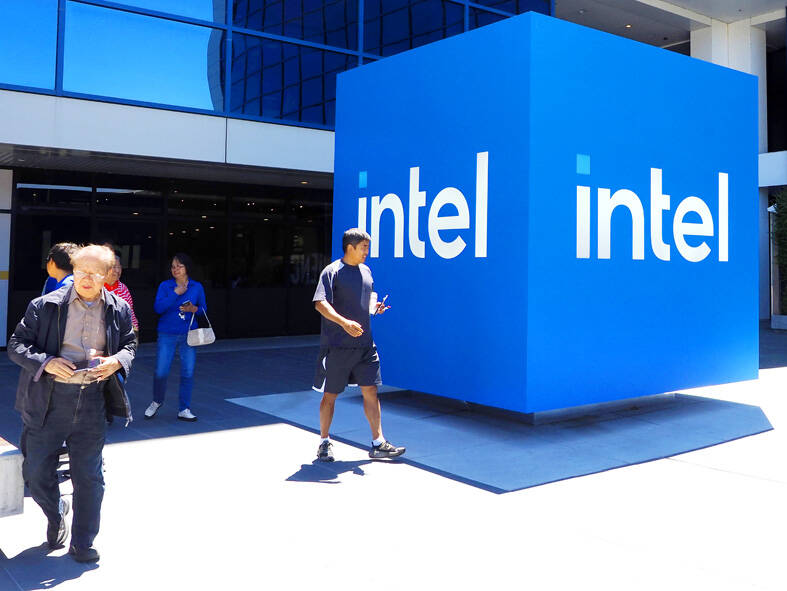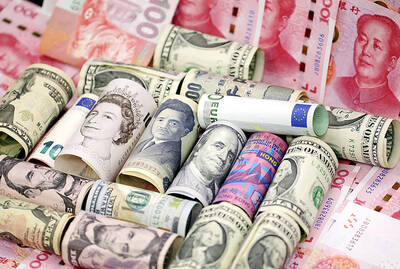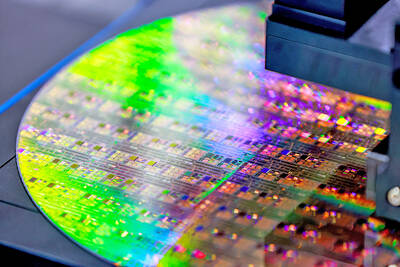Intel Corp tumbled in late trading after the company’s CEO Lip-Bu Tan (陳立武) sparked concerns that he was more focused on cost-cutting than restoring the chipmaker’s technological edge.
As part of Intel’s second-quarter report on Thursday, Tan said the company would cancel some factory projects and take a more conservative approach to future spending.
Tan called the investments begun under his predecessor, Pat Gelsinger, excessive and unwise.

Photo: EPA
“I do not subscribe to the belief that if you build it, they will come,” he said on a conference call with analysts.
At the same time, Tan struggled to give a clear picture of how he would make the company more competitive again. Gelsinger had embarked on an ambitious plan to turn Intel into a chip foundry, a business that makes products for outside clients. A key part of that was moving toward a more advanced production technique called 14A. However, Tan on Thursday signaled that Intel would only roll out that technology tentatively.
The company would add large-scale capacity for 14A when Tan is convinced he has enough customers committed to using it, he said on the call.
That did not sit well with investors, who sent the shares down about 5 percent in late trading.
“The idea you might step away from 14A if you can’t get someone to invest in it is a problem,” Wedbush Securities Inc analyst Matt Bryson said.
In its report, Intel gave an upbeat third-quarter sales forecast while missing estimates for some profit measures. Margins would be tighter than Wall Street anticipated in the period, and Intel only expects a break-even quarter. Analysts had projected a 4-cent gain on that basis.
In the second quarter, revenue amounted to US$12.9 billion, little changed from a year earlier. Analysts had projected US$11.9 billion. The company posted a loss of 10 cents a share, compared with an estimated profit of 1 cent.
Intel’s stock had been up 13 percent this year through the close.
Tan’s focus is getting Intel’s financial house in order, a task that has included thousands of layoffs and the slashing of capital spending.
The company also said that already-paused factories in Germany and Poland would not go ahead, and progress at another project in Ohio would be slowed.
Intel would reduce capital expenditures on new plants and equipment this year and plans to make further cuts to that budget next year. The company would spend about US$18 billion this year and less next year, executives said.
Tan, who took the CEO job in March, acknowledged that he still has work to do to make the company more competitive in its main markets: processors for personal computers and servers. He is also still crafting Intel’s plan to crack the artificial intelligence chip industry — an area Nvidia Corp dominates.
Third-quarter sales would be US$12.6 billion to US$13.6 billion, Intel said.
Analysts on average had projected a number at the low end of that range.
The company has benefited from a resurgence in the PC industry, driven in part by manufacturers’ efforts to build up inventory before tariffs hit.
Adjusted gross margin — the percentage of sales remaining after excluding the cost of production — was about 30 percent in the second quarter and would be 36 percent in the current period. That is close to half of what it was when Intel’s chips dominated the data center market.
Intel’s layoff plans would reduce staff by 15 percent, the company said, adding that it expects further cuts through attrition and the splitting off of business units.
The chipmaker aims to end the year with 75,000 employees, down more than 20 percent from the end of the June quarter.

Taiwan’s foreign exchange reserves hit a record high at the end of last month, surpassing the US$600 billion mark for the first time, the central bank said yesterday. Last month, the country’s foreign exchange reserves rose US$5.51 billion from a month earlier to reach US$602.94 billion due to an increase in returns from the central bank’s portfolio management, the movement of other foreign currencies in the portfolio against the US dollar and the bank’s efforts to smooth the volatility of the New Taiwan dollar. Department of Foreign Exchange Director-General Eugene Tsai (蔡炯民)said a rate cut cycle launched by the US Federal Reserve

The US government on Wednesday sanctioned more than two dozen companies in China, Turkey and the United Arab Emirates, including offshoots of a US chip firm, accusing the businesses of providing illicit support to Iran’s military or proxies. The US Department of Commerce included two subsidiaries of US-based chip distributor Arrow Electronics Inc (艾睿電子) on its so-called entity list published on the federal register for facilitating purchases by Iran’s proxies of US tech. Arrow spokesman John Hourigan said that the subsidiaries have been operating in full compliance with US export control regulations and his company is discussing with the US Bureau of

Businesses across the global semiconductor supply chain are bracing themselves for disruptions from an escalating trade war, after China imposed curbs on rare earth mineral exports and the US responded with additional tariffs and restrictions on software sales to the Asian nation. China’s restrictions, the most targeted move yet to limit supplies of rare earth materials, represent the first major attempt by Beijing to exercise long-arm jurisdiction over foreign companies to target the semiconductor industry, threatening to stall the chips powering the artificial intelligence (AI) boom. They prompted US President Donald Trump on Friday to announce that he would impose an additional

Pegatron Corp (和碩), a key assembler of Apple Inc’s iPhones, on Thursday reported a 12.3 percent year-on-year decline in revenue for last quarter to NT$257.86 billion (US$8.44 billion), but it expects revenue to improve in the second half on traditional holiday demand. The fourth quarter is usually the peak season for its communications products, a company official said on condition of anonymity. As Apple released its new iPhone 17 series early last month, sales in the communications segment rose sequentially last month, the official said. Shipments to Apple have been stable and in line with earlier expectations, they said. Pegatron shipped 2.4 million notebook